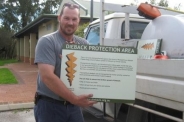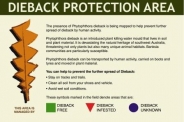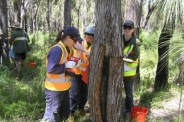Dieback (Phytophthora dieback)
The introduced plant pathogen Phytophthora cinnamomi is the cause of Phytophthora dieback disease (pronounced Fy-tof-thora - meaning plant destroyer in Greek). There are over 116 species of Phytophthora, but the species that causes the most severe and widespread damage to native plants in Western Australia is Phytophthora cinnamomi.
Dieback Best Management Practice Project
The introduced plant pathogen Phytophthora cinnamomi (cause of Phytophthora dieback disease) is a major threat to the biodiversity of the southwest of WA. Effective management procedures have been developed but they are not used consistently and routinely. Local Government Authorities (LGA's) manage many bushland reserves with high conservation values so implementation of effective dieback management procedures is critical to the long term sustainability of these areas.
The aim of this project is to increase the capacity, skills and knowledge of LGA's, community based environmental groups and private landholders leading to more effective management of Phytophthora dieback. The Phytophthora Dieback Best Practice Management Framework has been developed to help lead land managers through the process of assessing their current Phytophthora dieback management, integrate operating procedures and policies which are applicable to their organisation, allowing these to be reviewed and updated on a regular basis. The framework is a set of guidelines by which land managers can assess their compliance to best management practices thereby providing continuous quality development and leadership.
Implementation of the Phytophthora Dieback Best Practice Management Framework will enable land managers to more effectively manage Phytophthora dieback, minimising its spread and impact, thereby protecting biodiversity in all susceptible areas.
Further information and downloadable resources can be found on the Dieback Working Group website:
https://www.dwg.org.au/publications
Dieback Communications Strategy
The Dieback Communications Strategy was a ground breaking project to raise awareness and change the behaviour of reserve visitors to minimise the spread of Phytophthora dieback, a deadly introduced plant disease that can kill a wide variety of native WA plant species as well as garden plants such as strawberries, avocadoes and roses.
Funded by Lotterywest, the Dieback Communications Strategy was a partnership with EMRC, the Dieback Working Group, Perth Region NRM, Shire of Mundaring and the Cities of Swan, Armadale and Gosnells. The first of its kind in Western Australia, the strategy used feedback from the community through focus groups and surveys.
The EMRC was awarded the National Environs Australia 2009 Sustainability Award for Achievements in Sustainability for its work on the Dieback Communications Strategy.
The objectives of the project were to:
- Increase the level of awareness of dieback.
- Identify the actual attitudes and behaviours of community members.
- Develop communication tools that are effective in evoking measurable changes in behaviour for dieback containment in reserve management.
Research results included that respondents were able to dispel some of the "myths" about dieback:
- That it only affects jarrah (83.8% disagree).
- That it only affects the bush (69.6% disagree).
- That it is spread only by vehicles (67.7% disagree).
- That there is not much we can do to stop dieback spreading (73.2% disagree).
For more information on dieback, download the fact sheets below:
Fact Sheet - General Information - Phytophthora Dieback
Fact Sheet - Managing Phytophthora Dieback On Your Block and in Bushland
Fact Sheet - Managing Phytophthora Dieback in Nurseries
For more information contact:
Dieback Working Group at http://www.dwg.org.au/


